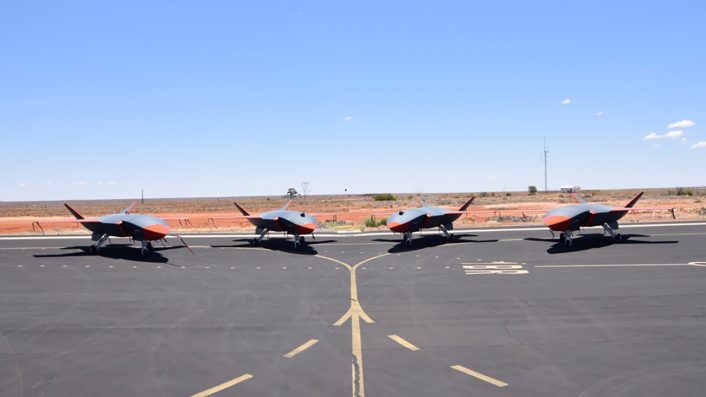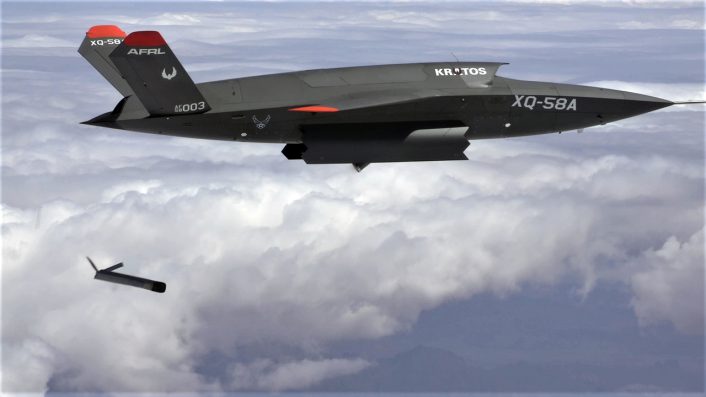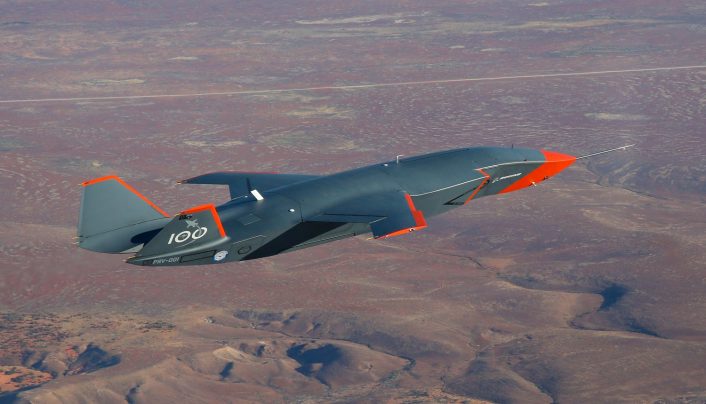Boeing Australia’s unmanned combat aerial vehicle will, according to plans, perform a live test launch of an air-to-air missile later in 2025 or in early 2026.
Announced to the media during the Avalon Australian International Airshow, the successful test of an air-to-air missile would be a significant step forward for the collaborative combat aircraft (CCA) platform. It will be the first time weapons have been integrated onto the MQ-28, which to date has largely been billed as an intelligence, surveillance, and reconnaissance (ISR) and electronic warfare (EW) force multiplier for manned aircraft.
Boeing confirmed that the Ghost Bat has completed 102 test flights across eight airframes. All of the airframes currently active are from Block 1, with two Block 2 aircraft in production. Block 2 aircraft feature a slight alteration to the wing design, along with new navigation equipment and increased hardening against electronic warfare attacks. Many of the improvements have been informed by the flight testing of Block 1 aircraft.

By the end of 2025 it is also hoped that Ghost Bat missions will be flown alongside F-35A Lightning II and E-7A Wedgetail aircraft. These aircraft will in the near future be operated by both the Royal Australian Air Force (RAAF) and the U.S. Air Force (USAF), who are touted as a potential future customer.
The Ghost Bat has been developed by Boeing’s Australian division, working closely with the RAAF. Official press releases are quick to note the MQ-28 as being the first Australian-built aircraft in over 50 years. Construction began in 2024 on a 9,000 square meter production plant in Toowoomba, Queensland that Boeing Australia hopes will be ready within three years.
The production facility – building MQ-28 Ghost Bats designed to support surveillance and intelligence – is expected to bring up to $1bn in economic benefit to our state. #qldpol #qldjobs pic.twitter.com/AJzhCBbwby
— Cameron Dick (@camerondickqld) March 26, 2024
Steve Parker, who currently serves as interim President and Chief Executive Officer at Boeing Defense, Space & Security, said the exact type of air-to-air missile that the test will involve will be announced at a later date. He also hinted at future tests of anti-surface weapons: “We’ll definitely look at air-ground in the future, but our focus priority is air-to-air.”
Adding weapons to the MQ-28 brings it closer in line with other CCA platforms like the Kratos XQ-58 Valkyrie, which is being evaluated by the U.S. military. Not only would these unmanned aircraft, teaming with manned aircraft, allow for additional ammunition to be carried, but the unmanned aircraft could be sent into high-risk situations in order to deliver a payload without the potential loss of human crew members.

Managing Director of Boeing Australia Amy List confirmed that although future funding for the MQ-28 program is not currently secured, the company is actively negotiating with the Australian government for a new round of investment.
The RAAF’s plans
The RAAF might soon provide the Australian government with the recommendations about the procurement of the uncrewed aircraft. “We have to provide options to government going forward, and we will likely do that by the end of the year, but certainly within the next 12 months,” said Air Vice-Marshal Nicholas Hogan, RAAF Head of Air Force Capability.
Considering the tight cooperation between the RAAF and Boeing Australia during the development, it is safe to say that the Ghost Bat will have a prominent role in the service’s plans. The RAAF appears to have a good opinion of the MQ-28, as highlighted by Hogan’s enthusiastic words.
“My view of the MQ-28: it’s world class,” said Hogan. “No doubt in my mind, it is world-leading. MQ-28 will be a very strong contender in any options we take forward to government.”
As mentioned earlier, the Ghost Bat is undergoing extensive testing, with 102 test flights reported so far and is providing a large quantity of data to the RAAF, allowing the grasp a better understanding of how this unmanned system works and how it can be integrated within the ranks.
✔️ 100 flights!
Our MQ-28 program, in partnership with @AusAirForce, has notched up 100 test flights. Together we’re leading the way in advancing a critical Collaborative Combat Capability for Australia and our allies. pic.twitter.com/Ds2OivmGXV
— Boeing Australia (@BoeingAustralia) March 25, 2025
“And what we have learned, in turn, the way it works, autonomously and teams with crew platforms, is exceptional,” Hogan said. “Even if we were to look at another platform or other platforms, I should say, I think the underlying foundation of what we learned from this platform will stay with us for decades.”
Australia and the U.S. are sharing data about the performance of the unmanned systems, added Hogan, as part of a trilateral cooperation with Japan on UAVs. The Australian and U.S. programs, however, have some different objectives, one of them being the latter’s weapons integration to support NGAD’s air superiority missions while the former will initially focus on sensors and testing the integration within the RAAF’s operating concept.
Hogan further confirmed that the program currently doesn’t include the integration of weapon systems on the MQ-28, but he also doesn’t exclude it for the future. “I wouldn’t discount that, but I wouldn’t say it was a definite,” said Hogan.

The service is, in fact, still working on the concept of operations of the unmanned aircraft and how to best employ it in concert with its manned fighters and support aircraft, and the data from the Ghost Bat test campaign is a big part of that work. “I just think we don’t quite understand how much this will change Air Force going forward,” Hogan said.
It is still early for the final decision by the Australian government to procure an unmanned combat aircraft and whether to proceed with the MQ-28 or another design, however Hogan envisions them to be in frontline service within 10 years. “I would be confident in saying that we would have autonomous, collaborative platforms as part of our inventory by that stage,” he said.
The Anduril Fury
American defense industry newcomer Anduril Industries used the airshow to pitch their CCA offering, internally named the Fury. The airframe traces its roots to Blue Force Technologies, which was acquired by Anduril in 2023. It has received the USAF designation YFQ-44.
Unlike Ghost Bat, Anduril’s design has yet to take flight, though this is planned to take place during 2025. David Goodrich, Chief Executive at Anduril Australia and Asia Pacific, stated that the company had already participated in some discussions and processes with the RAAF but could not clarify further details.
Fury down under: Anduril’s uncrewed fighter makes overseas debut at Avalon https://t.co/qzuoAOqoMW pic.twitter.com/jmG9l43O53
— FlightGlobal (@FlightGlobal) March 24, 2025
Comparing the two offerings with the limited available specifications is difficult, though we do know that the Ghost Bat is notably larger than the Fury. The latter is listed as 6.1 meters in length, with a wingspan of 5.2 meters. Ghost Bat, meanwhile, is 11.7 meters in length and spans 7.3 meters. The increased size may provide Ghost Bat with a greater endurance, and would certainly allow for more flexibility in terms of payload. However, the Fury may offer greater speed and maneuverability.
Importantly for Australia’s considerations given Ghost Bat’s pedigree, Anduril has stated that local production would be on the table should the nation place an order for their product. The company has already invested in an Australian production facility for its Ghost Shark autonomous underwater vehicle.
Goodrich believes Anduril’s unique selling point is their ability to deliver at a lower budget and a higher cadence compared to competitors, highly leveraging the company’s experience in artificial intelligence (AI) and robotics. “Fury has been designed for simplicity and large-scale production” he states. “Hardware and material choices are optimised around cost, speed, simplicity and supply chain.”
Talks have taken place with unspecified potential customers in the Indo-Pacific region, and the company is also planning to bring the Fury to the Paris Air Show in June to connect with the European market.
The Air Force’s first two Collaborative Combat Aircraft #CCA are fighters, the first uncrewed aircraft to carry such a designation. General Atomics’ CCA will be called the YFQ–42A and Anduril Industries’ CCA will be dubbed the YFQ–44A. Via @ASForcesMag 🔗👇 pic.twitter.com/1yvdp6MzvJ
— AirPower 2.0 (MIL_STD) (@AirPowerNEW1) March 4, 2025
In the U.S. the Anduril design will face off against General Atomics’ Gambit, designated YFQ-42. The two designs are the finalists for Increment 1 of the USAF’s Collaborative Combat Aircraft program. The service intends to procure up to 150 units in this increment, though it is unclear whether one design of the two will be chosen or if a mixed fleet will be put into service.
Industry giants Boeing, Lockheed Martin, and Northrop Grumman were not selected for Increment 1, but are able to bid for Increment 2. Lockheed Martin believes they over-delivered for Increment 1, providing a ‘gold-plated’ option that would have been cost prohibitive. For Increment 2 the company is targeting a more affordable offering which will be closely linked to F-35 Lightning II developments.








